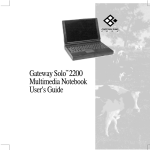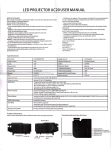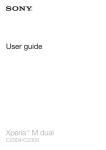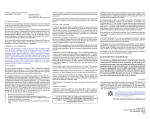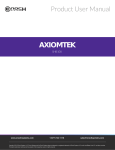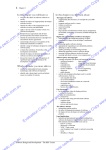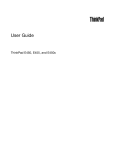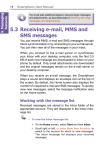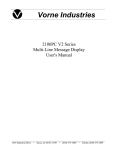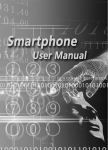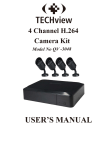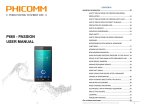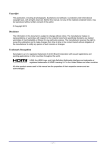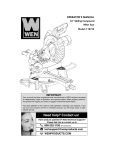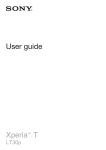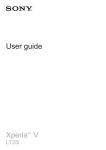Download SOLO 2100 USER MANUAL
Transcript
User’s Guide 1 Thank you for purchasing this Factory Service Manual CD/DVD from servicemanuals4u.com. Please check out our eBay auctions for more great deals on Factory Service Manuals: servicemanuals4u 2 Gateway Solo™ 2100 Multimedia Notebook Contents Legal notices .............................................................. 4 Specifications .............................................................. 6 If you don’t read anything else . . . Read this! ....................................... 8 System Overview .......................................... 9 Outside the System ......................................................... 10 Inside the System .......................................................... 12 Getting Started .......................................... 13 Connecting AC Power ...................................................... Powering up the System ..................................................... Power button setting .................................................... LCD Display .............................................................. Keyboard ................................................................ Key combinations/hot keys ................................................ EZ Pad Pointing Device ...................................................... Customizing the EZ Pad .................................................. Windows 95 ............................................................. Start button ........................................................... Task bar .............................................................. Windows 95 manual ..................................................... On-line documentation ................................................... Ordering manuals ....................................................... 14 15 15 17 18 18 22 23 24 25 25 25 25 25 Modularity/Connectivity ................................... 27 Batteries ................................................................ Charging/discharging the battery pack ........................................ Battery status .......................................................... Removing the battery pack ................................................ Modular Option Bay ........................................................ Modular CD-ROM, floppy disk drive, and battery pack ............................. Swapping modules ...................................................... External Floppy Drive Adapter ................................................. Hard Disk Drive ........................................................... Memory ................................................................ PCMCIA Cards ............................................................ Connections ............................................................. IR port ............................................................... Gateway 2000 Solo™ mini-docking station ..................................... 28 28 29 30 31 31 32 33 34 35 37 38 38 39 User’s Guide 3 Using the System ........................................ 41 Built-in Microphone/Stereo Speakers ............................................. Making an Audio Recording .................................................. Loading a Screen Saver ...................................................... Playing an Audio CD ....................................................... Using a Modem ........................................................... 42 43 44 45 46 Advanced Topics ......................................... 49 Power-Saving Modes ....................................................... Standby mode ......................................................... Suspend/Resume mode................................................... Rebooting ............................................................ Setup Menus ............................................................. Main menu ........................................................... Advanced menu ........................................................ Security menu ......................................................... Power menu .......................................................... Exit menu ............................................................ Popup Status Display ....................................................... Port/IRQ Configurations ..................................................... Zoomed Video ............................................................ 50 50 50 50 51 52 54 56 59 61 62 63 64 Accessories ............................................. 65 Maintenance/Troubleshooting .............................. 67 Care and Maintenance ...................................................... Virus Checking ............................................................ Hard Drive Utilities ......................................................... Disk defragmenter ...................................................... ScanDisk ............................................................. Reformatting the Hard Disk Drive ............................................... Troubleshooting ........................................................... Start up .............................................................. General .............................................................. Frequently asked questions ................................................ Important Information ...................................................... Calling Gateway 2000 U.S. ................................................ Calling Gateway 2000 outside the U.S. ........................................ 68 69 70 70 70 71 72 72 73 74 76 77 77 Index .................................................. 78 4 Gateway Solo™ 2100 Multimedia Notebook Legal notices Gateway Solo™ 2100 Multimedia Notebook User’s Guide Copyright © 1996 Gateway 2000® 610 Gateway Drive North Sioux City, SD 57049 USA All rights reserved FCC statement This book is protected by copyright and all rights are reserved. No part of it may be reproduced or transmitted by any means or in any form without prior written consent from Gateway 2000. Note: This equipment has been tested and found to comply with the limits for a Class B digital device pursuant to Part 15 of the FCC Rules. These limits are designed to provide reasonable protection against harmful interference in a residential installation. This equipment generates, uses, and can radiate radio frequency energy and, if not installed and used in accordance with the instructions, may cause harmful interference to radio communications. However, there is no guarantee that interference will not occur in a particular installation. If this equipment does cause harmful interference to radio or television reception, which can be determined by turning the equipment off and on, the user is encouraged to try to correct the interference by one or more of the following measures: The information in this manual has been carefully checked and is believed to be accurate. However, Gateway 2000 assumes no responsibility for any inaccuracies that may be contained in this manual. In no event will Gateway 2000 be liable for direct, indirect, special, incidental, or consequential damages resulting from any defect or omission in this manual, even if advised of the possibility of such damages. In the interest of continued product development, Gateway 2000 reserves the right to make improvements in this manual and the products it describes at any time, without notice or obligation. Trademark acknowledgments AnyKey, cow spot motif, Gateway 2000, TelePath, stylized “G” design, and motto “You’ve got a friend in the business” are registered trademarks of Gateway 2000. EZ Pad, EZ Point, Gateway Solo, GW2K, and Vivitron are trademarks of Gateway 2000. Intel is a registered trademark of Intel Corporation. Microsoft, MS, MS-DOS, and Windows are trademarks or registered trademarks of Microsoft Corporation. All other product names mentioned herein are used for identification purposes only, and may be the trademarks or registered trademarks of their respective companies. u Reorient or relocate the receiving antenna u Increase the separation between the equipment and receiver u Connect the equipment into an outlet on a circuit different from that to which the receiver is connected u Consult an experienced radio/TV technician for help. Caution: Changes or modifications not expressly approved by the party responsible for compliance could void the user’s authority to operate the equipment. To meet FCC requirements, shielded cables are required to connect this device to any other Class B certified device. INDUSTRY CANADA Notice — For the customers in Canada This apparatus complies with the Class B limits for radio noise emissions set out in Radio Interference Regulations. INDUSTRIE CANADA Notice — Pour les utilisateurs au Canada Cet appareil est conforme aux normes Classe B pourbruits radioélectriques, spécifiés dans le Règlement sur le broullage. User’s Guide 5 Cautions and Warnings Caution: Danger of explosion if battery is incorrectly replaced. The battery can pose a fire or chemical burn hazard if mistreated. Do not disassemble, heat above 60°C (140°F), or incinerate. Replace only with the same or equivalent type recommended by the manufacturer. Dispose of used batteries promptly and according to the manufacturer’s instructions. Attention: Il y a danger d’explosion s’il y a replacement incorrect de la batterie. Remplacer uniquenment avec une batteries du meme type ou d’un type recommande par le constructeur. Mettre rebut les batteries usagees conformement aux instructions du fabricant. Vorsicht: Explosionsgefahr bei unsachgemäßem Batteriewechsel. Originalbatterien nur durch gleiche oder vom Hersteller empfohlene Batterien ersetzen. Gebrauchte Batterien an Gateway 2000 zurücksenden. Advarsel: Eksplosjonsfare ved feilaktig skifte av batteri. Benytt samme batteritype eller en tilsvarende type anbefalt av apparatfabrikanten. Brukte batterier kasseres i henhold til fabrikantens instruksjoner. Caution: Replace the cord if it becomes damaged. U.S. and Canadian replacement cords must be UL-approved (CSA certified in Canada) type SPT-2, 18 AWG, 2conductor cord with permanently attached NEMA type 1-15P plug at one end and a permanently attached S1 connector body on the other. Cord length may not exceed 15 feet. Outside the U.S. and Canada the cord must be rated for at least 250VAC at 10 amps, and must indicate international safety agency approval. The plug must be a type appropriate for the country of use. Obtain replacement cords at an authorized service center. The replacement must be of the same type and voltage rating as the original cord. Vorsicht: Beschädigte Kabel ersetzen. Ersatzkabel in den USA und Kanada müssen folgende Bedingungen erfüllen: UL-anerkannter (in Kanada CSA-zertifizierter) SPT-2 Typ, 18 AWG, 2-Leiter-Kabel mit fest installiertem NEMA-Typ-1-15P-Stecker und fest installierter Anschlußdose am anderen Ende, max. 4,57 m Länge. Außerhalb der USA und Kanada gelten folgende Bedingungen: Kabel für mindestens 250 V Wechselstrom bei 10 A, anerkannt durch internationale Sicherheitsbehörde, landesspezifischer Stecker. Ersatzkabel nur im Fachhandel erwerben. Nur Ersatzkabel des gleichen Typs und für die gleiche Spannung (Voltzahl) wie das Originalkabel verwenden. Warning: Always plug the cord into an easily accessible outlet near the equipment so that unplugging the cord is an easy way to shut off power. Do not attempt to disassemble the AC adapter. The AC adapter has no user-replaceable or user-serviceable parts inside. The AC adapter has dangerous voltages that can cause serious personal injury or death. Return defective AC adapters to Gateway 2000. The AC adapter is intended for use with a computer. Both must meet EN 60950. Achtung: Netzkabel stets in eine gut zugängliche Steckdose nahe der Ausrüstung einstecken, um durch einfaches Ziehen des Steckers jederzeit die Stromversorgung unterbrechen zu können. Den Adapter unter keinen Umständen auseinanderbauen. Der Adapter enthält keine vom Benutzer zu ersetzenden oder zu wartenden Bestandteile. Die Spannung im Adapter kann beim Auseinanderbau zu Verletzungen oder Tod führen. Beschädigte Adapter an Gateway 2000 zurücksenden. Der Adapter ist für den Gebrauch mit einem Computer bestimmt. Adapter und Computer müssen die Norm EN 60950 erfüllen. Environmental considerations Your Gateway Solo 2100 Multimedia Notebook has been engineered to provide many years of reliable service. However, you should give it the same reasonable care and protection that you would any other electronic equipment. Damage caused by dropping the Gateway Solo 2100 Multimedia Notebook, impact with another object, or immersion in liquids is not covered by the warranty. Never expose the Gateway Solo 2100 Multimedia Notebook to rain, snow, or moisture. Avoid locations with high levels of dirt, dust, or smoke. CAUTION: DO NOT OPEN. NO USER SERVICEABLE PARTS INSIDE. ATTENTION: NE OUVRIER PAS. PARTIS RÉPARABLES UNIQUEMENT Á L'USINE. VORSICHT: NICHT ÖFFNEN. ENTHÄLT KEINE VOM BENUTZER ZU WARTENDEN BESTANDTEILE. In our effort to use nature’s resources efficiently and wisely, Gateway 2000 prints all manuals on recycled papers that meet the minimum requirements established by the Federal EPA in its guidelines for recycled paper products. Printed in the United States of America Part # SYSMAN032AAUS 8501011 MAN US SYS SL21 USR GDE 6/96 6 Gateway Solo™ 2100 Multimedia Notebook Specifications (Specifications are subject to change without notice or obligation.) CPU Cache Intel Pentium™ 100, 120, or 133MHz, TCP packaging 256K pipelined burst level 2 RAM Core logic EDO; 8MB minimum, expandable to 40MB Intel 82430MX (Mobile Triton I), PCI bus Clock frequency 50/60/66MHz BIOS Phoenix; 256KB Flash ROM LCD panel size LCD panel resolution 11.3″ DSTN, 11.3″ TFT, 12.1″ TFT SVGA 800 × 600 LCD panel color depth TFT: 65,536 colors (16-bit) at SVGA resolution; DSTN: 256 colors at SVGA resolution External video Supports simultaneous LCD/External monitor External video resolution 640 × 480 with 16 million colors to 1024 × 768 with 256 colors Video Cirrus 7548 with DCI/Direct draw capability, GUI motion video acceleration, continuous X/Y upscaling to 1024 × 768, and an enhanced Bit-BLT engine Video interface 32-bit PCI bus with 64-bit memory interface Video memory Zoomed video 1MB EDO RAM PCMCIA connection to zoomed video port Keyboard 85 keys (U.S.), full size 19mm pitch; 2.7mm travel; provides same functions as standard Windows 95 AT keyboard; US, UK English, German, French, and Japan available Mouse/Pointer External ports EZ Pad integrated pointer; PS/2-type connector for external mouse IRDA-1 IR port, serial port (16550A-compatible), parallel (bi-directional, EPP, ECP), video, PS/2 keyboard/mouse, docking station connector, PCMCIA Type III or two Type I or II card socket, line in, speaker out, and microphone Battery pack Li-Ion 35W, 14.4V; Batteries can be ”warm-swapped“ in the battery bay without rebooting. Recharges in system. Conforms to APM 1.2 standard Second battery A second battery can be installed and charged in the modular drive bay Batterylife Battery charge time Approximately 2.5 hours with one battery and APM enabled 1.5 hours with the system off; 3.0 hours with the system operating; times double if two batteries are installed User’s Guide 7 AC adapter Modular drive bay 19VDC, 45W output; auto voltage adjustment between 100 and 240V Internal 1.44MB 3.5″ floppy drive, 5″ CD-ROM drive, or battery pack Hard disk drive Removable; accepts 2.5″, 12.5mm hard disk drive; 540MB, 810MB and 1.3GB Hard disk controller Floppy disk drive Enhanced IDE, on PCI bus Removable; 1.44MB 3.5″ floppy drive; ”hot-swappable“ with optional second battery pack; optional adapter allows external connection CD-ROM drive Removable; 6X XA mode 2 compatible Audio chipset ESS 1888 stereo sound Speakers Speakers built-in to palm rest Microphone Omnidirectional microphone under LCD panel on right Mini-docking station Two serial, one parallel, VGA output, DC-in, line out, PS/2 keyboard, PS/2 mouse, MIDI/game port, one PCMCIA Type III or two Type II; ”hot-dockable“ Accessories AC adapter; IR (infrared) module; lithium battery; mini-docking station; hard drives; memory modules; external floppy disk drive adapter; leather carrying case, nylon carrying case; external speakers; modem; ethernet cards Dimensions (W × D × H) 11.3″ × 8.97″ × 1.93″ (288mm × 228mm × 49mm) Weight System weight: 6.9 lbs with battery and CD-ROM drive Traveling weight: 7.7 lbs with battery, CD-ROM drive and AC adapter Operating temperature Storage temperature 5 to 35°C -20 to 60°C Operating humidity Storage humidity 20 to 80%; noncondensing relative humidity 8 to 90%; noncondensing relative humidity Operating altitude 8000 feet; nonpressurized (Doesnot refer to pressurized commercial aircraft) Storage altitude 40,000 feet; nonpressurized Certification FCC Class B, UL1950, TUV/EN60950, CSA 22.2 8 Gateway Solo™ 2100 Multimedia Notebook If you don’t read anything else . . . Read this! Your Gateway Solo™ 2100 Multimedia Notebook provides all the power and multimedia capabilities of a full-size desktop system, yet allows you the convenience of a lightweight portable notebook. à See page 31. à See page 33. à See page 35. à See page 34. à See page 39. à See page 31. à See page 57. à See page 62. à See page 64. The Gateway Solo 2100 contains the following special features: System Modularity — The system has a modular option bay that accepts either a floppy disk drive module, a CD-ROM module or an additional battery pack. Note: Be sure to remove any cardboard inserts that may have shipped with your CD-ROM module or floppy disk drive module. The floppy disk drive module has an optional external adapter so you can use the floppy disk drive module and CD-ROM at the same time, or use the floppy disk drive module with an additional battery pack. Install additional memory modules with ease. Swapped out the hard drive with another hard disk drive. Use the optional mini-docking station to save time by plugging in peripherals and leaving them plugged in. The mini-docking station easily connects to the rear of the system, enabling all attached peripherals. Dual Battery Operation — To operate with two batteries at the same time, install one battery pack in the battery bay and an optional second battery pack in the modular option bay. This option is ideal when you travel, providing additional hours of uninterrupted use. Plug in the AC adapter, and charge both battery packs at the same time. Backup Password Protection — Selecting this option from the Security menu in the Setup menus will allow you to access your system if you have forgotten your password. Place and store the supervisor password on a diskette in a hidden file. Popup Status Display — Through a set of hot key options you can monitor battery status, temporarily change the power management level, view AC adapter connection, view mute function enabled/disabled, change volume settings, change brightness levels or change contrast levels (DSTN models only). Zoomed Video — The video information for most PC cards goes through the CPU or system bus, taking up additional processing time. Zoomed video routes the video information directly to the video card, freeing up the processor for other tasks. User’s Guide 1 System Overview Outside the System.................. 10 Inside the System ................... 12 9 10 Gateway Solo™ 2100 Multimedia Notebook Outside the System Take a quick tour of the system to familiarize yourself with the options available. Cover latch Modular option bay: Floppy disk drive module installed. Battery bay Figure 1. Front View Rubber foot Retaining pin guide hole: For optional mini-docking station. Figure 2. Bottom View Modular option bay release latch Retaining pin guide hole: For optional mini-docking station. Battery bay release latch Expansion memory access panel Rubber foot Hard drive access cover User’s Guide AC Connector: Connect the AC adapter here. Floppy/ParallelPort: Connect an external floppy diskdriveorotherparallel devicehere. 11 SerialPort: Connect any serial devicehere. 120-Pin Docking Station Port: Connect the optional mini-docking station here. VGA Port: Connect any standard monitor here. Figure 3. Rear View IR port: Place the transmitter/receiver within two feet so it can “see” the port. Mic: Connect an external microphone here (disables internal microphone). Linein: Connect external audio source here. Headphones: PS/2 port: Connect headphones or Connect an external speakers here external mouse or (disables built-in speakers). keyboard here. Figure 4. Right Side View PCMCIA eject buttons Figure 5. Left Side View PCMCIA slots: Accepts two Type I or Type II cards or oneTypeIIIcard. Kensington lock slot Hard drive access 12 Gateway Solo™ 2100 Multimedia Notebook Inside the System LCD color display: 11.3-inch DSTN, 11.3-inchTFT,or 12.1-inchTFT System LEDs Built-in microphone: Can record meetings, etc. Power button Stereo speakers Full-sized keyboard: Windows 95 keys and special function keys. Stereo speakers Battery bay Figure 6. Interior View EZ Pad™ pointing device: Controls the cursor like a mouse. Power LED Battery charging power LED Caps Lock LED Pad Lock LED Figure 7. System LEDs Modular option bay: CD-ROM module installed. Scroll Lock LED Floppy disk drive LED Hard disk drive LED User’s Guide 13 2 Getting Started Connecting the AC Power ............ 14 Powering Up the System ............. 15 LCD Display........................ 17 Keyboard ......................... 18 EZ Pad............................ 22 Windows 95 Basics.................. 24 14 Gateway Solo™ 2100 Multimedia Notebook Connecting AC Power The first time you use the Gateway Solo™ 2100 Multimedia Notebook, use the AC adapter to fully charge the battery and provide the system with a constant supply of power. Caution: Replace the power cord if it becomes damaged. The replacement cord must be of the same type and voltage rating as the original cord. To 1. 2. 3. connect the AC power adapter to the system: Plug the AC adapter into the system’s AC connector. Connect the power cord to the AC adapter. Plug the power cord into an electrical outlet. AC adapter Power cord Figure 8. AC Power Connection Warning: Do not attempt to disassemble the AC adapter. The AC adapter has no user-replaceable or user-serviceable parts inside. The AC adapter has dangerous voltages that can cause serious personal injury or death. Return defective AC adapters to Gateway 2000. User’s Guide 15 Powering up the System à See page 10. Slide the latch on the front face of the system to the right to release the à See page 59. cover, and open up the system. The power button is located in the upper left corner on the notebook surface. The power button on your system is preset in On/Off mode. However, you can set it to function either inOn/Off orSuspend/Resume mode. This setting affects the manner in which your system operates. Power button Figure 9. Locating the Power Button Power button setting When the power button setting in the Power menu is On/Off and: u the system is off, press the power button to turnOn the computer. u the system is on, press the power button to turn the computercompletelyOff. Remember, turning the system completely off when the power button is set for On/Off mode causes every part of the computer to power down. Any unsaved work will be lost! Pressing the power button willreboot the system. à See page 50. When the power button setting in the Power menu is Suspend/Resume and: u the system is off (in Suspend mode), press the power button to Resume power to the computer. u the system is on, press the power button to cause the computer to enter Suspend mode. u Press and hold the power button for two seconds to turn the system completely Off. Remember, when the system is on and set for Suspend/Resume mode, pressing the power button does not completely turn off the computer and the system does not reboot. You must press and hold the power button for two seconds to completely power down the system. 16 Gateway Solo™ 2100 Multimedia Notebook To check/change the power button setting: 1. Turn the system on. 2. Press the F2 key when you see the message Press <F2> to access SETUP in the lower left corner of the display, before Windows 95 loads, to access the Setup menus. The system beeps, then the Main menu appears. 3. Using the Right Arrow key, move to the Power menu. 4. The first available option isPowerbuttonmode:. If the setting displayed is the one you want, go to Step 6. 5. Press the Spacebar to change the setting. 6. Press the ESC key to access the Exit menu. 7. PressEnter to Save changes & exit, then pressEnter again, or use the Down Arrow key to select any other option. User’s Guide 17 LCD Display The Gateway Solo™ 2100 Multimedia Notebook features a built-in, backlit, color LCD display. This display is either an 11.3-inch DSTN, 11.3-inch TFT, or 12.1-inch TFT display. Each of these SVGA displays provides sharp, crisp resolution and crystal clear color. Figure 10. LCD Display à See page 19. Tilt the system’s entire cover forward or backward to adjust the viewing angle. Press the Fn key together with the Left Arrow andRight Arrow keys to control display contrast (DSTN display only), or press theFn key together with the Up Arrow and Down Arrow keys to control display brightness. Pressing theFn key together with theF1 (Display Off) key will toggle off the display and save power. Press any key to reactivate the display. A few small dots of color may occasionally appear on the screen. This is normal and does not affect the overall screen image. Connect an external monitor to the computer through the VGA port on the rear of the system, or the VGA port on the optional mini-docking station. Press the Fn key with the F3 (LCD/CRT) key to toggle between active displays. à See page 60. Note: This system ships with theAuto dim with battery only feature enabled. Auto dim cuts LCD power 50% when the system is operating on battery power. 18 Gateway Solo™ 2100 Multimedia Notebook Keyboard The Gateway Solo 2100 Multimedia Notebook features an 85-key keyboard. To provide the full functionality of a 101/102-key keyboard, many of these keys have been assigned alternate functions, including shortcut keys for Windows® 95 and Popup Status Display menus. Connect an external keyboard through the PS/2 port on the rear of the system, or the PS/2 (keyboard) port on the optional mini-docking station. Hot Function Keys Fn Key Windows 95 Start Button Key Numeric Keypad Windows 95 Start Button Windows 95 Brightness or Contrast Key Menu Key (DSTN only) keys Figure 11. Keyboard Key combinations/hot keys For normal key functions: u Press the key alone to get standard lowercase letters, numerals and punctuation marks. u Press the key together with theShift key to get standard uppercase letters and symbols. User’s Guide 19 Press one of the following keys (with blue letters) together with theFn key to get these specific functions. Key Combination à See page 17. à See page 62. à See page 17. à See page 50. à See page 21. + + + + Description Turns the LCD display off to reserve power. Press any key to restore the display. Displays thepower status display for the Popup Status Display program in the upper left corner of the Windows 95 desktop. After four seconds, the display disappears. Toggles between the LCD display, external CRT display, or both displays at the same time as the active display. Places the system in Suspend mode. Press the power button to resume power to the notebook. + Makes temporary changes to the power management mode setting and displays thepower status display for the Popup Status Display program reflecting the changes. After four seconds, the display disappears. + Enables and disables the mute function and displays thepower status display for the Popup Status Display program reflecting the changes. After four seconds, the display disappears. + Decreases the system volume level and displays thevolume meter for the Popup Status Display reflecting the changes. After four seconds, the display disappears. + Increases the system volume level and displays thevolume meter for the Popup Status Display reflecting the changes. After four seconds, the display disappears. + Enables the Pad Lock function, so you can access the embedded numeric keypad. The Pad Lock LED stays lit while this function is enabled. Press the key combination again to disable. + + + + + + + + In some programs you can scroll through large volumes of text. The Scroll Lock LED stays lit as long as this function is enabled. Toggles between expanded and non-expanded video mode. Some DOS games need a 640 x 480 video display (TFT only). Places the system briefly into Standby mode. Press any key to resume power to the system. System Requirement. This key combination is reserved. Will print the screen if an external printer is connected to the system. Pauses the display when text is scrolling very quickly. Press the key combination again to restart the text flow. In some programs this key combination breaks the text. Press the key combination again to restart the text flow. In some programs this key combination will send you to the starting point of your text. 20 Gateway Solo™ 2100 Multimedia Notebook Key Combination à See page 62. + + Description In some programs this key combination sends you to the ending point of your text. Increases LCD brightness and displays thebrightness meter for the Popup Status Display reflecting the changes. After four seconds, the icon disappears. + Decreases LCD brightness and displays thebrightness meter for the Popup Status Display reflecting the changes. After four seconds, the icon disappears. + Increases LCD contrast (DSTN only) and displays thecontrast meter for the Popup Status Display reflecting the changes. After four seconds, the icon disappears. + Decreases LCD contrast (DSTN only) and displays thecontrast meter for the Popup Status Display reflecting the changes. After four seconds, the icon disappears. Table 1. Function Keys/Hot Keys User’s Guide à See page 19. 21 Press the Fn and Pad Lock keys together, then press one of the following keys to activate keys in the numeric keypad. Key Combination Description Pressing the 7 key produces a 7 when the Pad Lock function is enabled. Pressing the 8 key produces an8 when the Pad Lock function is enabled. Pressing the 9 key produces a 9 when the Pad Lock function is enabled. Pressing the zero key produces a/ when the Pad Lock function is enabled. Pressing the U key produces a4 when the Pad Lock function is enabled. Pressing the I key produces a5 when the Pad Lock function is enabled. Pressing the O key produces a 6 when the Pad Lock function is enabled. Pressing the P key produces an* when the Pad Lock function is enabled. Pressing the J key produces a 1 when the Pad Lock function is enabled. Pressing the K key produces a2 when the Pad Lock function is enabled. Pressing the L key produces a3 when the Pad Lock function is enabled. Pressing the ; key produces a- when the Pad Lock function is enabled. Pressing the M key produces a0 when the Pad Lock function is enabled. Pressing the . key produces a. when the Pad Lock function is enabled. Pressing the / key produces a+ when the Pad Lock function is enabled. Table 2. Numeric Keypad Combinations 22 Gateway Solo™ 2100 Multimedia Notebook EZ Pad Pointing Device Like a mouse, the EZ Pad pointing device controls the movements of the cursor on the screen. Press a finger against the pad, then slide it in the direction you want the cursor to move. Use the mouse buttons or tap on the pad to select something. Pad: Slide finger across pad to control cursor movement. Tap on the pad to emulate the mouse button. Left mouse button Right mouse button Figure 12. EZ Pad There are two ways to click: u Position the cursor on the item and press the left mouse button once. u Position the cursor on the item and tap on the pad once. There are two ways to double-click: u Position the cursor on the item and press the left mouse button twice. u Position the cursor on the item and tap on the pad twice. There are two ways to drag and drop: u Position the cursor on the item and hold down the left mouse button while sliding your finger to reposition the cursor, then release the mouse button. u Position the cursor on the item, tap on the pad twice; after the second tap, hold and slide (without lifting your finger) to reposition the cursor, then lift your finger to release. User’s Guide 23 Customizing the EZ Pad You can adjust mouse button configuration, drag, edge motion, cursor’s speed, rate, size and disable the pad tap. To customize the EZ Pad: 1. Clicking onStart, Settings, and Control Panel. 2. Double-click on theMouse icon. 3. Click on each of the different tabs to see the options available. Experiment with the different options and find the ones most comfortable for you. Refer to your Windows 95 documentation for further information. Note: The mouse may become erratic and hard to control if your fingers have excess moisture or perspiration. You can attach an external mouse to the notebook through the PS/2 port on the back of the notebook or the PS/2 (mouse) port on the optional minidocking station. It is not necessary to power down the system when connecting an external mouse. 24 Gateway Solo™ 2100 Multimedia Notebook Windows 95 Once you initiate Windows 95, the first thing that appears on the display is the Welcome to Windows 95 screen. This screen provides a Windows tour, information about what’s new, the opportunity to register your software online, information about Windows products and useful tips. Figure 13. Welcome to Windows 95 Screen Click theWindows Tour button to start a brief tour of the operating system. This tour provides information on starting a program, exploring your disk, finding a file, switching windows and using Help. Click on the button next to the topic that you are interested in, then follow the screen prompts. If you have any questions about the instructions, click on theShow Me button. Click the Exit button and follow any screen prompts when you are finished. Click onWhat’sNew for information more experienced users might find useful. This screen gives an overview of changes between earlier versions of Windows and Windows 95. Click on the box next to the topic you are interested in. Click on theX in the upper right corner of the window to close the screen. Click on theOnline Registration button to register your software using a tollfree number. You will need a modem to access this option. Click onProduct Catalog to see what other Windows options are available for purchase. You must load the Windows 95 CD-ROM in the CD-ROM module to access this option. ClickingNextTip provides operational tips, which are displayed in theDid you know... section of the Welcome to Windows 95 screen. Click on either theClose button, or theX in the upper right corner of the Welcome screen to close it and start using Windows 95. User’s Guide 25 Start button The start button is located in the bottom left corner of the Windows 95 desktop and accesses the Start menu. Most programs and applications are launched via the Start menu. To access the menu, click on the Start button or press one of theÿkeys. Figure 14. Windows 95 Start Button Task bar The task bar is located along the bottom of the Windows 95 desktop. The task bar contains the start button in the left corner and displays all active/ running programs. If a program has been minimized, click on the program name in the task bar to restore it. Figure 15. Windows 95 Task Bar Windows 95 manual If you have additional questions regarding Windows 95, check the Windows 95 manual you received with your notebook. Please use this manual as a reference for all Windows 95 questions. On-line documentation Some of the software packages that came with your notebook contain online documentation. Check the Help option which is featured in each software package. Ordering manuals If you prefer paper manuals, you can purchase them at an additional cost through the Document Offer Program. Order forms are included in the information pack that came with your system software CDs. 26 Gateway Solo™ 2100 Multimedia Notebook User’s Guide 27 3 Modularity/Connectivity Batteries .......................... 28 Modular Option Bay ................. 31 External Floppy Drive Adapter ......... 33 Hard Disk Drive ..................... 34 Additional Memory .................. 35 PCMCIA Cards ...................... 37 Connections ....................... 38 28 Gateway Solo™ 2100 Multimedia Notebook Batteries à See page 10. When you first receive your system, the battery is installed in the battery bay, but will not have a full charge. The battery bay is located in the right front panel of the system. We recommend that you completely charge, then discharge the batterytwice. This optimizes the battery’s life and performance. Figure 16. Battery Pack (bottom view) Charging/discharging the battery pack à See page 31. The battery must be installed in the notebook and connected to an AC power source to charge completely. The battery will charge if the system is operating, as long as the AC adapter is properly connected. For twice the battery life, you can install an optional second battery pack in the modular option bay. The notebook can run on a fully charged battery for about two and a half hours of normal use before the battery needs recharging. System Status Idle Operating One Pack Charge Time 1.5 hours 3 hours Two Packs Charge Time 3 hours 6 hours Table 3. Battery Charging Chart à See page 59. Note: Your battery performance may vary, depending on power management settings and usage. User’s Guide à See page 12. à See page 25. WARNING! LOW BATTERY 29 When the battery level gets low: u The system emits three beeps u The battery charging power LED flashes u Thebattery icon in the lower right of the task bar has a red ”X“ over it u The power status display appears, flashing a warning in the upper left corner of the display u The Low Battery screen appears, advising you to change your battery or switch to AC power immediately to prevent losing your work. Once the battery pack is fully discharged, reconnect the AC adapter to the notebook to recharge the battery. Battery status BAT1 85% BAT2 00% PM OFF USER DEF AC ON MUTE à See page 25. You can check battery status several ways. u Click onStart, Settings, andControl Panel. Double click on thePower icon. You can view the battery status and set power preferences from this screen, which stay in effect until they are changed in Windows. Click on theX in the upper right corner of the screen to close it. u Press the Fn key together with theF2 (Popup) key, or theF5 (PM) key. The power status display appears in the upper left corner of the display. This display monitors battery status, power management selection, and mute function status. BAT1 monitors the status of the battery pack in the battery bay. BAT2 monitors the status of the optional second battery pack, which can be installed in the modular option bay. After four seconds of inactivity, the display will disappear. u Position the cursor over thepower cord (AC) orbattery icon in the lower right corner of the task bar. A battery status screen will appear. Moving the cursor anywhere on the display causes the screen to disappear. u Click twice on thepower cord or battery icon in the lower right corner of the task bar. A more detailed battery status screen will appear. Click on theX in the upper right corner of the screen to close it. 30 Gateway Solo™ 2100 Multimedia Notebook Removing the battery pack à See page 50. à See page 19. While the battery pack may not be charged by itself, battery packscan be ”warm-swapped“ in the battery bay. This means you can change battery packs while in Suspend mode without totally rebooting the system. To remove/replace the battery pack: 1. Save all work. 2. Press the Fn key together with theF4 (Suspend) key to put the system into suspend mode, or press and hold the power button for two seconds if the power button is configured for Suspend/Resume mode. 3. Close the cover and turn the system over. 4. Slide the battery release latch to the left. 5. Hold the latch in place and place your fingers over the raised bar on the battery pack next to the latch. 6. Slide the battery pack straight out and away from the system. 7. Slide a charged battery pack (bottom side up) straight into the battery bay until it ”snaps“ into place. 8. Turn the notebook right side up and open the cover. 9. Press the power button to resume power to the system. Battery release latch Figure 17. Locating the Battery Release Latch Figure 18. Removing the Battery Pack Warning: The battery can pose a fire or chemical burn hazard if mistreated. Do not attempt to disassemble, heat above 60°C (140°F), or incinerate. User’s Guide 31 Modular Option Bay The Gateway Solo™ 2100 Multimedia Notebook features a modular option bay located in the right front panel of the notebook. This bay accepts the modular CD-ROM drive, the modular internal floppy disk drive, or an optional additional battery pack. The modular option bay houses either drive or the battery pack, but only one at a time. Note: Be sure to remove any cardboard inserts that may have shipped with your CD-ROM module or floppy disk drive module. Figure 19. Locating the Modular Option Bay Modular option bay: Floppy disk drive module installed. Note: Be sure to save and exit any applications before initiating any of the following procedures. To use CD-ROM and floppy disk drive functions simultaneously, install the modular CD-ROM drive and connect an external floppy drive to the floppy/ parallel port on the rear of the system or the optional docking station, or use the optional external floppy drive adapter for the floppy disk drive module. Modular CD-ROM, floppy disk drive, and battery pack Figure 20. CD-ROM (bottom view) Figure 21. Floppy Disk Drive (bottom view) Figure 22. Battery Pack (bottom view) 32 Gateway Solo™ 2100 Multimedia Notebook Swapping modules The floppy disk drive module and the battery pack are ”hot-swappable“ in the modular option bay. This means that you can change between battery packs or from battery pack to floppy disk drive and back again without having to reboot the system.This does not, however, apply to the CD-ROM. To ensure that the system can recognize and read it, the CD-ROM must already be installed when you boot up the system. If the system is on when you install or remove the CD-ROM, the operating system will not ”recognize“ or”find“it. To switch between the CD-ROM module and another module: 1. Save all work. 2. Press the power button, or press and hold the power button for two seconds if you configured the power button for Suspend/Resume mode to turn the system completely off. 3. Close the cover and turn the system over. 4. Locate the modular bay access latch, and slide the latch to the right. 5. Hold the latch in place, then place your fingers over the raised bar next to the latch. 6. Pull the CD-ROM module straight out and away from the system. 7. Turn the floppy disk drive module or battery pack over. The system was turned over, so the module being installed must be turned over as well. 8. Push the module straight into the bay until the latch locks into place. 9. Restart the system. Modular option bay release latch Figure 23. Locating the Release Latch Figure 24. Removing the Module User’s Guide 33 External Floppy Drive Adapter You can connect an optional external floppy disk drive to the floppy/parallel port on the back of the system. You can also connect the external drive to the floppy/parallel port on the optional mini-docking station. The connection requires the floppy drive cable that was provided with yourexternal floppy disk drive, or the optional external floppy drive adapter for the modular floppy disk drive. It is not necessary to reboot the system for it to recognize the external floppy disk drive connection. To connect the external floppy disk drive: 1. Connect the parallel connector of the floppy drive cable to the floppy/ parallel port on the system, or the floppy/parallel port on the optional mini-docking station. 2. Connect the floppy drive cable’s other connector to the connector on the external floppy drive. Note: If the internal floppy disk drive module is already installed in the modular optional bay, the external floppy disk drive will not be recognized. To connect the optional external floppy drive adapter and floppy disk drive module: 1. Attach the parallel connector of the external floppy drive adapter to the floppy/parallel port on the system, or the floppy/parallel port on the optional mini-docking station. 2. Slide the floppy disk drive module straight into the external floppy drive adapter until the latch locks into place. Figure 25. External Floppy Drive Adapter Figure 26. Inserting the Floppy Drive Module Note: Remember, you do not need to reboot the system for it to recognize the external floppy disk drive connection. 34 Gateway Solo™ 2100 Multimedia Notebook Hard Disk Drive You can remove the system’s hard disk drive (HDD) from the system for replacement, or to switch between optional additional hard drives. Figure 27. Hard Disk Drive (bottom view) To remove and replace the hard disk drive: 1. Save all work. 2. Press the power button, or press and hold the power button for two seconds if you configured the power button for Suspend/Resume mode to turn the system completely off. 3. Close the lid. 4. Disconnect the AC power and turn the system over. à See page 30. 5. Remove the battery pack. 6. Locate the hard disk drive (HDD). 7. Remove the three screws holding the drive in place and set them aside. 8. Gently slide the hard drive away from the system. 9. Slide the new hard drive all the way into the system. Caution: Do not force the hard drive. 10. Replace the three screws and gently tighten the drive into place. 11. Reinstall the battery pack and AC connections. Figure 28. Locating the Hard Disk Drive Figure 29. Removing the Hard Disk Drive User’s Guide 35 Memory The system ships with at least 8MB of RAM on board. The RAM capacity can be upgraded to 40MB by installing optional memory modules in the two expandable memory sockets, located on the underside of the system. These sockets accept 8MB or 16MB modules. Figure 30. Memory Module To install a memory module: 1. Save all work. 2. Press the power button, or press and hold the power button for two seconds if you configured the power button for Suspend/Resume mode to turn the system completely off. 3. Close the lid. 4. Follow electrostatic discharge precautions when adding memory. Preventing Electrostatic Discharge (ESD) Damage The components inside your system are extremely sensitive to electrostatic discharge, better known as static electricity. Static electricity can cause irreparable damage to your system; however, if you follow the Sequential Procedure for grounding yourself and take note of the Handling Precautions, you should easily be able to avoid the possibility of such damageoccurring. Sequential Procedure 1. Wear a grounding wrist strap if one is available (available at most electronic stores). 2. Turn off the system power. 3. Remove the battery pack. 4. Remove all the cables. Handling Precautions o Never slide memory modules or other parts over any surface. Avoid static-causing surfaces such as plastic and styrofoam in your work area. o Remove the part from its antistatic bag only when you are ready to use it. Do not lay the part on the outside of the antistatic bag, as only the inside of the bag provides antistatic protection. o Always hold cards by their edges and their metal mounting bracket. Avoid touching components on the cards and the edge connectors that connect to expansion slots. 5. Disconnect the AC power. 36 Gateway Solo™ 2100 Multimedia Notebook à See page 30. 6. 7. 8. 9. Turn the system over and remove the battery pack. Locate the memory module access panel. Remove the screw and set it aside. Use your thumb to press against the edge of the expansion memory access panel and lift it away. 10. Gently insert the memory module into one of the sockets. Caution: Do not force the memory module. 11. Replace the memory access panel and the screw. 12. Reinstall the battery and reconnect the AC power. 13. Power up the system. Figure 31. Locating the Memory Module Access Figure 32. Locating the Memory Module Socket Figure 33. Inserting a Memory Module à See page 53. If you choose, you can verify the additional memory through theMain menu. User’s Guide 37 PCMCIA Cards The system’s PC card slots are located behind the PC card door on the left side of the system. These slots accept two Type II PC cards or one Type III card. Since these are recessed slots, you can shut the door even when a PC card is installed. The system is preconfigured to automatically accept most PC cards. However, some PC cards, such as Zoomed Video cards, may require additional drivers. Refer to the PC card’s documentation. Figure 34. PC Card To install a PC card: 1. Flip open the PC card door on the left side of the system. 2. Select a PC card to install. à See page 64. 3. Locate the PC card slot in which you wish to install the card. If you are installing a Type III PC card or Zoomed Video card, it must be inserted into the bottom slot. 4. Slide the card into the chosen slot and operate the device as recommended in the PC card’s manual. Figure 35. Installing a PC Card à See page 25. To remove a PC card: 1. Click on the PC card icon in the right corner of the task bar. A control screen appears. 2. Click on the screen and another screen appears stating it is safe to remove the device. ClickOK. 3. Press the appropriate eject button located to the left of the PC card slot and remove the card. You do not need to reboot the system when changing most cards because it supports ”hot-swapping.“ This means you can usually just exchange one card for another. See your PC card’s documentation for further information. 38 Gateway Solo™ 2100 Multimedia Notebook Connections The system uses a variety of hardware to connect to peripheral devices or to other computer systems. When the Gateway Solo™ 2100 Multimedia Notebook connects to another system, that system is called the ”remote system.“ IR port The IRDA-1 IR (infrared) port and optional module uses infrared technology to send signals between the notebook and a remote system. The IR port is located on the right side of the system. It can send signals, as well as receive them. A variety of desktop computers, printers and other peripherals are IRcompatible. Placing the Gateway Solo 2100’s IR port within three feet (one meter) of another unit’s IR port along with transfer software, will allow you to send and receive information to that remote desktop computer, printer or other peripheral. The optional module (the receiver/transmitter) must be placed no farther away than three feet (one meter), with the module’s IR port directly facing the Gateway Solo 2100’s IR port. The other end connects to the remote system’s serial port. Figure 36. IR Port IR port User’s Guide 39 Gateway 2000 Solo™ mini-docking station The optional mini-docking station, or port replicator, duplicates many of the connectors and ports found on the system such as a line-out jack for audio, a MIDI/game port, PCMCIA slots, and an extra PS/2 port. Peripheral devices—such as an external keyboard, mouse, or joystick—connect to the minidocking station, which then is connected to the system. VGA port: Connect any standard monitor here. PS/2 (mouse) port AC power connector PS/2 (keyboard) port MIDI/Game port: Connect a musical device or joystick here. Serial port: Connect any serial devicehere. Floppy/Parallel port: Connect a floppy disk drive or any parallel device here. Figure 37. Mini-Docking Station - Rear View PCMCIA slots: Two available Mini-docking station retaining pins (2) Eject buttons Figure 38. Mini-Docking Station - Right Side View IR port Mini-docking station retaining pins (2) Mic Linein Headphones Figure 39. Mini-Docking Station - Left Side View The system connects to (or disconnects from) the mini-docking station with a few short steps. 40 Gateway Solo™ 2100 Multimedia Notebook To 1. 2. 3. à See page 10. 4. 5. 6. 7. 8. connect the optional Gateway 2000 Solo™ mini-docking station: Save all work. Close the lid. Open the longer of the two port doors at the rear of the system. The port door will slide into the system leaving a flush mounting area. Open the handle on the mini-docking station. Place the front edge of the mini-docking station under the rear of the system. The two mini-docking station retaining pins will settle into the two retaining pin guide holes on the insides of the raised rubber feet. Close the handle on the mini-docking station to secure the connection. Connect peripherals to the ports on the mini-docking station. Open the lid Mini-docking station handle Gateway Solo™ 2100 Multimedia Notebook Mini-docking station Gateway Solo™ 2100 Multimedia Notebook Mini-docking station Figure 40. Connecting the Mini-Docking Station To disconnect the Gateway 2000 Solo™ mini-docking station: 1. Open the handle on the mini-docking station. 2. Lift the system up off the retaining pins. 3. Move the mini-docking station away from the system. Note: Remember, you can leave the peripherals connected to the minidocking station for future use. User’s Guide 41 4 Using the System Built-in Microphone/Speakers .......... 42 Recording a Meeting ................ 43 Loading a Screen Saver............... 44 Playing an Audio CD................. 45 Using a Modem..................... 46 42 Gateway Solo™ 2100 Multimedia Notebook Built-in Microphone/Stereo Speakers This system contains a built-in microphone and stereo speakers. Built-in microphone Stereo speakers Stereo speakers Figure 41. Locating the Built-in Speakers and Microphone There are several ways to control the volume. u Click onStart, Settings, and Control Panel. Double click on theMultimedia icon. You can change the volume from theAudio tab. Click on the X in the upper right corner of the screen to close it. à See page 62. u Press the Fn key together with theF7 (Volumet), or F8 (Volumes) key. A volume meter will appear in the upper left corner of the display. Hold the Fn key while tapping theF7 or F8 key to increase or decrease the volume level by single increments. After four seconds of inactivity, the display will disappear. à See page 25. u Click once on thespeaker icon in the lower right corner of the task bar. A volume control screen will appear. Using the EZ Pad, slide the pointer up or down to change the volume setting. Click once anywhere on the Windows 95 desktop to close the screen. u Click twice on thespeaker icon in the lower right corner of the start bar. A more detailed volume control screen will appear, containing volume and balance controls for volume control, wave, CD audio and synthesizer settings. Using the EZ Pad, slide the pointers to the left or right to control balance, or up or down to change the volume setting. Click on theX in the upper right corner of the screen to close it. Use the audio ports on the right side of the system, or the audio ports on the optional mini-docking station to add external speakers, headphones or a microphone. User’s Guide 43 Making an Audio Recording Use the built-in microphone, or connect an external microphone using the Mic port on the right side of the system to make an audio recording. Note: Remember, connecting an external microphone will disable the builtin microphone. To make an audio recording: 1. Click onStart, Programs, Accessories, Multimedia, andSound Recorder to access theSound - Sound Recorder screen. 2. Click onEdit and Audio Properties to set/check record volume levels. 3. Click onFile and New to begin a recording. 4. Slide the mouse pointer slowly over the control buttons along the bottom of the screen to display the function of each button. 5. Click on thel (Record) button to start recording. 6. Click on then (Stop) button to end recording. 7. Click on File and SaveAs... to name and store the recording. You can play back the recording in eitherSound Recorder, orMedia Player. To play back the recording in Media Player: 1. Click onStart, Programs, Accessories, Multimedia, thenMedia Player to access theMedia Player screen. 2. Click onFile, thenOpen.... 3. Select the file to play back and click theOpen button. 4. Slide the mouse pointer slowly over the control buttons along the bottom of the screen to display the function of each button. 5. Click on theu (Play) button to start the recording. 6. Click on then (Stop) button to end recording. 44 Gateway Solo™ 2100 Multimedia Notebook Loading a Screen Saver Screen savers perform a valuable function for your system. The system will go into Screen Saver mode after the user-established time has passed. A screen saver keeps a moving picture on the screen to prevent ghosting. Different screen saver packages on the market reflect a variety of interests. If you are installing another screen saver, refer to the documentation that came with the package for specific installation instructions. To load a Windows 95 resident screen saver: 1. Click onStart, Settings, andControl Panel. 2. Double-click on theDisplay icon to access theDisplay Properties screen. 3. Click on theScreen Saver tab to access the available resident screen saver programs. 4. Click on one of the screen saver options. An example of the screen appears on the simulated display. 5. Click onSettings to customize your selection. 6. Click on thes or t buttons to the right of theWait: section of theDisplay Properties screen to set the time the system waits before going into Screen Saver mode. 7. Click Ok when you have made all of your selections. 8. Click on theX in the upper right corner of theControl Panel to close the screen. Experiment with the different settings and choose the ones that work best for you. User’s Guide 45 Playing an Audio CD The Gateway Solo™ 2100 Multimedia Notebook contains all the key features needed to enjoy your favorite audio CDs. Note: There must be power (either battery or AC) to the system before you can open the CD-ROM tray. à See page 32. To play an audio CD: 1. Make sure the CD-ROM drive module is installed in the modular option bay. 2. Press the eject button on the front of the CD-ROM drive module. 3. Gently pull the CD-ROM tray fully open and place the audio CD into the tray. 4. Push in the CD-ROM tray until it closes completely. 5. The CD will start playing automatically. 6. Click on theCD Player option that appears in the task bar along the bottom of the display, or click onStart, Programs, Accessories, Multimedia, and CD Player to access the CD Player screen. You can change music tracks, view playing times, control the volume, set preferences, define a play list and even set the system to continuous or random play through this screen. 7. Slide the mouse pointer slowly over the control buttons on theCD Player screen to display the function of each button. 8. Click on theEject button in theCD Player screen, or press the eject button on the front of the CD-ROM drive when you have finished listening. 9. Gently pull the CD-ROM tray fully open and remove the CD; then close the tray completely. Experiment with the different settings in theCD Player screen to find the ones that work best for you. 46 Gateway Solo™ 2100 Multimedia Notebook Using a Modem Installing and using a modem with the Gateway Solo™ 2100 Multimedia Notebook is an easy process. If you have ordered the TelePath 28.8 data/fax modem with your notebook, the drivers for the modem have already been preloaded onto the system. Caution: Do not use your TelePath modem on a digital phone line. Modems convert digital signals into analog signals that can be sent on normal, analog telephone lines. If you attempt to use the modem on a line that is already digital,the TelePath data/fax modem has built-in protection, and will not work. Some modems could become permanently unusable. Most digital lines are in-house PBX systems. If you have any doubts about the type of line you have, ask your telephone service supplier. To install the TelePath 28.8 data/fax modem: 1. Using the APM connector: Plug the APM connector end of the modem cable into the APM connector end of the modem (see Figure 42). If you have trouble plugging it in, turn the connector over. à See page 37. Using the XJACK: Gently push on the end of the jack and release. The jack will pop out. Plug an RJ-11 connectorfrom above into the XJACK (see Figure 43). 2. Insert the modem face up, 68-pin connector first, into the PCMCIA slot in the left rear side of the notebook. Press the modem gently, but firmly into the PCMCIA slot until it will go no farther. Donot force the modem. 3. Plug the jack end of the modem cable into the RJ-11 wall jack. Use an RJ11 connector and extension telephone cable if you need a longer cord for your modem. 4. The modem is now enabled and ready to use. RJ-11 connector APM connector XJACK Figure 42. Making an APM Connection Figure 43. Making an XJACK Connection User’s Guide 47 If you purchased the modem after the system, you will need to perfom a few additional steps to enable the modem. à See page 31. To enable the TelePath 28.8 modem: 1. Make sure the floppy disk drive module is installed in the modular option bay, or connect the optional external floppy disk drive and install the floppy drive module. 2. Once the modem has been installed, the New Hardware Found window appears. 3. Click on the circle next toDriver from disk provided by hardware manufacturer so a black dot appears in the center of that circle. TheInstall from Disk window appears. 4. Insert the driver disk into the floppy disk drive module (usually designated driveA:). 5. Type: a: on the command line provided, then click Ok. The Select Device window appears. 6. SelectGateway 2000 TelePath 28.8 XJACK PCMCIA, and clickOk. 7. The modem is now enabled. Once your modem is connected you can talk to the world, or send and receive faxes on your system. Several on-line services are accessible via your modem. Check your Gateway Solo™ 2100 System CD for an OLS directory that contains an overview of three different on-line services and registration information. 48 Gateway Solo™ 2100 Multimedia Notebook User’s Guide 49 5 Advanced Topics Power Saving Modes ................ 50 Setup Menus ....................... 51 Popup Status Display ................ 62 Port/IRQ Configurations .............. 63 Zoomed Video ..................... 64 50 Gateway Solo™ 2100 Multimedia Notebook Power-Saving Modes If the system goes through long periods of inactivity, the system utilizes two power-saving modes. Standby mode à See page 59. The system enters Standby mode if you do not use the keyboard or EZ Pad within the amount of time allotted by your power management choices (set in the Power menu). The hard disk drive spins down, the screen goes blank, and the AC power LED remains steady green. Using the keyboard or EZ Pad sends the system from Standby mode back to its active mode. After approximately ten minutes of Standby mode, depending upon your power management choices, the system automatically shifts to Suspend mode. Suspend/Resume mode à See page 60. à See page 19. RESUMING PLEASE WAIT.... The system enters Suspend mode after approximately ten minutes of Standby mode (depending on timeout setting). The system will also enter Suspend mode from the active mode if you clickStart thenSuspend, press theFn key together with the F4 (Suspend) key or press the power button when it is configured forSuspend/Resume. During Suspend mode the hard disk drive spins down, the screen goes blank and the AC power LED slowly flashes. It looks like the system has been powered down. Actually, the computer is conserving power and resources as well as saving all current work. The notebook can stay in Suspend mode for up to one week on a fully charged battery! You should still save work to the hard drive as often as possible. To exit Suspend mode, press the power button. The computer leaves Suspend mode and returns to its previous state.It does not reboot! When the system powers up, thepower status display flashes briefly in the upper left corner of the display. Rebooting If the system stops responding to the EZ Pad or the keyboard, it can usually be fixed by one of the following procedures: u Press Fn key together withF4 (Suspend) key to put the notebook into Suspend mode and wait about ten seconds; then press the power button to put the notebook back in Resume mode. u Press theCtrl, Alt, andDel keys simultaneously. u Press and hold the power button for at least two seconds. User’s Guide 51 Setup Menus The Gateway Solo™ 2100 Multimedia Notebook contains a series of Setup menus that control basic setup, security, and power settings. You can modify the options controlled by these screens to tailor the system’s functionality to best support the way you use it. Note: All of the following illustrations depicting the Setup menus are shown with options set to the factory defaults. To access the Setup menus: 1. Power up the system. 2. Press the F2 key when you see the message Press <F2> to access SETUP in the lower left corner of the display before Windows 95 loads. The system beeps, then the Main menu appears. 3. Follow the instructions along the bottom of the menus to navigate through the different options and menus. An Item Specific Help bar providing additional information is also located along the right side of each menu. 52 Gateway Solo™ 2100 Multimedia Notebook Main menu The Main menu controls a variety of basic setup options. Figure 44. Main Menu Figure 45. IDE Adapter 0 Master Sub-Menu Figure 46. IDE Adapter 1 Master Sub-Menu Figure 47. IDE Adapter 1 Slave Sub-Menu The following provides a brief overview of the options controlled through the Main menu. System time: Controls the internal clock. To reset the clock, simply type in the correct values. System date: Controls the system date. Type in the correct values displayed as month/day/ year (mm/dd/yyyy). PressTab to access each field. User’s Guide 53 Diskette A: Selects the drive type. IDE Adapter 0 master: Note: Do not change these settings unless you are an advanced user! This sub-menu configures the IDE adapter (see Figure 45). PressEnter to access the sub-menu for this function. PressEsc when you have finished using the sub-menu, or wish to return to theMain menu. Autotype fixed disk: — Auto-detects the drive and sets all drive values to comply with ANSI specifications. Type: — Change from Auto to User to edit Cylinders, Heads, Sectors/ Track,etc. 32 bit I/O: — Enables or disables 32-bit data transfers. IDE Adapter 1 master: This sub-menu is only used with more than one hard drive. It functions the same as IDE Adapter 0 master. IDE Adapter 1 slave: This sub-menu is only used with more than one hard drive. It functions the same as IDE Adapter 0 master. Display device selection: Sets the video display device. Use theSpacebar to choose between LCD, CRT or both LCD & CRT. Built-in pointing device: Enables or disables the EZ Pad pointing device. Press theSpacebar to select Enabled orDisabled. Memory cache: Enables or disables external memory cache. Press theSpacebar to select Enabled orDisabled. Boot sequence: Sets the order in which the system searches for the boot drive. Press the Spacebar to choose between A: then C:, C: then A:, C: only, or CD-ROM. system memory and extended memory fields display the actual memory à See page 36. The available. You cannot access and change these fields. These fields will only change if additional memory or a larger hard drive is installed. Press the Esc key to access the Exit menu and accept/discard changes. Press F9 to return to the factory defaults, orF10 to return to the previous settings. Use the Right Arrow key to move over to the next screen. 54 Gateway Solo™ 2100 Multimedia Notebook Advanced menu The Advanced menu contains operating system, system allocation (IRQ and register settings) and port assignment (COM and LPT) information. Caution: Setting the options on the menu to incorrect values may cause the system to malfunction. Figure 48. Advanced Menu Figure 49. Integrated Peripherals Sub-Menu The following provides a brief overview of the options available through the Advanced menu. Integrated Peripherals: Press Enter to access the sub-menu that assigns port allocations and IRQ addresses (see Figure 49).See Table 4 for the available options. User’s Guide 55 Option To Change Setting Serialport Select, use theSpacebar to access: COM1: 3F8h IRQ4; COM2: 2F8h IRQ3; COM3: 3E8h IRQ4; COM4: 3E8h IRQ3; Disabled IR port Select, use theSpacebar to access: COM2: 2F8h IRQ3; COM3: 3E8h IRQ4; COM4: 3E8h IRQ3; Disabled; COM1: 3F8h IRQ4 Parallel port address Select, use theSpacebar to access: LPT1: 378h IRQ7; Disabled; LPT2: 278h IRQ5; LPT3: 378h IRQ7 Parallel port mode Select, use theSpacebar to access: ECP; Output Only; Bi-Directional Diskette controller Select, use theSpacebar to access: Enabled; Disabled On-board IDE adapter Select, use theSpacebar to access: Primary; Secondary; Disabled On-board stereo sound Select, use theSpacebar to access: Enabled; Disabled I/O channel Stereo sound enabled, select, use theSpacebar to access: 220H - 22FH; 230H - 23FH; 240H - 24FH; 250H - 25FH MPU channel Stereo sound enabled, select, use theSpacebar to access: 330H - 331H; 300H - 301H IRQ channel Stereo sound enabled, select, use theSpacebar to access: IRQ5; IRQ7; IRQ9; IRQ10 DMA channel low Stereo sound enabled, select, us theSpacebar to access: DMA1; DMA3; DMA0 DMA channel high Stereo sound enabled, select, us theSpacebar to access: DMA5, DMA6, DMA0 Table 4. Integrated Peripherals Menu Options Press Esc when you have finished using the sub-menu, or wish to return to the mainAdvanced menu. Plug & Play OS Set toYes for Windows 95. Set toNo if you are using a different operating system, or a PCMCIA card that needs real mode drivers (does not already have Windows 95 drivers). Reset configuration data Be careful with this setting, since this option clears system configuration at the next boot if set toYes. Large disk access mode: Set to On if your operating system is DOS or Windows. Set toOff if you are using any other operating system. Press the Esc key to access the Exit menu and accept/discard changes. Press F9 to return to the factory defaults, orF10 to return to the previous settings. Use the Right Arrow key to tab over to the next screen. 56 Gateway Solo™ 2100 Multimedia Notebook Security menu The Security menu contains options to set or change system passwords and set other system security precautions. Figure 50. Security Menu The following provides a brief overview of the options available through the Security menu. Set supervisor password Setting a supervisor password protects the system by preventing access to the BIOS setup without the password. TheSupervisor password is line near the top of the menu will reflect that the password has been enabled. To set a Supervisor password: 1. Use the Arrow keys to selectSet supervisor password from the Security menu, and press Enter to access the Set supervisor password screen. 2. Type in a password no more than seven characters long and press Enter. Try to think of a password that will be easy for you to remember, but difficult for someone else to guess. 3. Retype the password to verify, and pressEnter. A Notice screen appears. PressEnter to continue. User’s Guide 57 To disable the password function: Note: You still need the old password. If you have forgotten the password, this procedure will not allow you to access the Setup menus. 1. Make sure thatBoot password: is set toDisabled. 2. Use the Arrow keys to selectSet supervisor password and pressEnter. 3. Press Enter instead of entering a password. 4. PressEnter again to verify the lack of a password. ANotice screen appears. PressEnter to continue. 5. The Supervisor password is and User password is lines near the top of the menu should both stateDisabled. Set user password This option is only available if you have set a supervisor password. A user password allows limited access to BIOS setup with the password. TheUser password is line near the top of the menu will reflect that the password has been enabled. To set a user password: 1. Use the Arrow keys to select Set user password from the Security menu, and pressEnter to access theSet user password screen. 2. Type in a password no more than seven characters long and press Enter. Try to think of a password that will be easy for you to remember, but difficult for someone else to guess. 3. Retype the password to verify, and pressEnter. ANotice screen appears. PressEnter to continue. Backup password: This function makes a backup copy of the supervisor password onto a floppy disk. If you forget your password, insert the floppy disk and change the supervisor password. Make sure you label the diskette containing the backup password file. It is a hidden file and cannot be seen or read. Note: We strongly recommend that you take advantage of Backup password: if you are using passwords. We have made the password function very secure. There is no easy way to erase a forgotten password. If you have not used the Backup password: function, you must send the system back to Gateway 2000 for a time-consuming repair. To backup the supervisor password: 1. Make sure the floppy disk drive module is installed in the modular option bay. 2. Place a floppy diskette in the drive and pressEnter. ANotice screen appears. PressEnter to continue. 3. Label and store the diskette in a safe place. 58 Gateway Solo™ 2100 Multimedia Notebook To restore the supervisor password using the backup password diskette: à See page 31. 1. Make sure the floppy disk drive module is installed in the modular option bay. 2. Power up the system. 3. Press F2 when prompted along the bottom of the display. 4. The Enter password (from floppy press enter): screen appears. Place the backup diskette in the drive and pressEnter. 5. Use the Right Arrow key to move to the Security menu, then press Enter. 6. Type in a new password and press Enter. 7. Retype the new password to verify, and pressEnter. A Notice screen appears. PressEnter to continue. 8. Back up the password again on diskette using theBackup password: by placing a floppy diskette in the drive and pressingEnter twice. 9. Store the backup password diskette in a safe place. Boot password: Setting this feature toEnabled requires the supervisor or user password to boot the system. Press theSpacebar to selectEnabled orDisabled. Floppy drive access: Note: This function only works ifBoot password is enabled. If this function is set toSupervisor, you need the supervisor password to access the floppy disk drive. If it is set toUser, you need the supervisor or user password to access the floppy disk drive. Press theSpacebar to select Supervisor or User. Fixed disk boot sector: If set toWrite protect, the boot sector of the hard disk drive is write-protected to help prevent viruses. However, you cannot add software or format the hard drive. Press theSpacebar to selectWrite protect orNormal. System backup reminder: This function will display a message at bootup reminding you to back up your system files. Press theSpacebar to chooseDaily, Weekly (every Monday),Monthly (1st day of the month) orDisabled. à See page 69. Virus check reminder: This function will display a message at bootup reminding you to run a virus check program. Press the Spacebar to choose Daily, Weekly (every Monday), Monthly (1st day of the month) orDisabled. Press the Esc key to access the Exit menu and accept/discard changes. Press F9 to return to the factory defaults, orF10 to return to the previous settings. Use the Right Arrow key to tab over to the next screen. User’s Guide 59 Power menu The Power menu contains the power management settings and system timeouts. Figure 51. Power Menu The following provides a brief overview of the options available through the Power menu. à See page 15. Power button mode: Sets power button functionality. Press theSpacebar to selectOn/Off orSuspend/Resume. PM Control: Sets the power management mode environment. Press the Spacebar to choose betweenBattery, Disabled or Always. Power Management: This function provides preset or customized power management. Setting this option to Minimum Battery Life provides the notebook with bestsystem performance. Setting this option toMaximum Battery Life provides the system with bestbattery performance. Setting this option toCustomize allows you to manually set the Standby, Suspend, Hard disk and Video timeouts. Setting this option toMedium provides the system with a mixture ofsystem and battery performance. Use the Spacebar to choose between options. à See page 50. Standby timeout: The time that the system waits before going into Standby mode. The Power Management: function must be set toCustomize before you can change this field. Use theSpacebar to choose2, 4, 6, 8, 10... through30, orOff. 60 Gateway Solo™ 2100 Multimedia Notebook à See page 50. Suspend timeout: The time that the system waitsafter the notebook is in Standby mode, before going into Suspend mode. ThePower Management: function must be set to Customize before you can change this field. Use the Spacebar to choose2, 4, 6, 8, 10... through30, orOff. Hard disk timeout: The time that the system waits before the hard drive spins down into a ”rest“ mode. ThePower Management: function must be set toCustomize before you can change this field. Use theSpacebar to choose2, 4, 6, 8, 10... through 14, orOff. Video timeout: The time that the system waits before going into ”video rest.“ ThePower Management: function must be set toCustomize before you can change this field. Use theSpacebar to choose2, 4, 6, 8, 10... through14, orOff. Resume on time: Turning this featureOn will ”wake“ the system up at the time specified in the Resume time: field. Use theSpacebar to selectOn orOff. Resume time: Sets a specific time the system will ”wake“ from Suspend mode. Use theTab key to access each field and type in the desired values. Battery low suspend: When this feature is enabled, the system automatically enters Suspend mode when the battery gets low. Use theSpacebar to selectOn orOff. Auto dim with battery only: When this feature is enabled, the LCD brightness automatically decreases by 50% when using battery power only. Use the Spacebar to select On or Off. Press the Esc key to access the Exit menu and accept/discard changes. Press F9 to return to the factory defaults, andF10 to return to the previous settings. Use theRight Arrow key to tab over to the next screen. User’s Guide 61 Exit menu The Exit menu contains the options available once you have made changes to the Setup menus. Options available in this menu: u Save changes & exit u Exit without saving changes u Load default values u Load previous values u Save changes. Figure 52. Exit menu Use the Arrow keys to make your selection and follow all screen prompts. 62 Gateway Solo™ 2100 Multimedia Notebook Popup Status Display The Popup menu display feature is supported by the VGA controller chip and the system BIOS. The displays appear in the upper left corner of the display, and disappear after four seconds of inactivity. Popup menus: u Power status display u Volume meter u Contrast meter BAT1 85% BAT2 00% PM OFF USER DEF AC ON MUTE WARNING! LOW BATTERY VOLUME llllllllllllll CONTRAST llllllllllllll BRIGHT llllllllllllll u Brightness meter. Power status display — This display appears when you press the Fn key together with theF2 (Popup) or theF5 (PM) key. It shows current battery status, power management level and mute function (if enabled). The display is updated when you change any function choice. Battery status is displayed in the top two lines. The top line reflects the status of the primary battery pack. The second line reflects the status of the optional battery pack installed in the modular option bay. If the battery level is low, a warning icon will appear. The power management levels are displayed in the third and fourth lines. You can toggle between levels by pressing theFn key together with the F5 (PM) key. Note: These changes in power management levels are temporary and do not affect the power settings in the BIOS Setup screens. The changes areonly in effect until the system is rebooted or powered off, then the BIOS power settings are restored. AC power status is monitored on the fifth line. The mute function is enabled or disabled when you press the Fn key together with theF6 (Mute) key. Thepower status display will briefly appear. The bottom line will display the word MUTE when enabled, and be blank when disabled. Volume meter — This meter shows the system volume level. Press the Fn key and tap the F8 (Volume s) or F7 (Volume t) key to increase or decrease the contrast level in single increments. Contrast meter — This meter shows the LCD display contrast levels (DSTN displays only). Press theFn key and tap theLeft Arrow or Right Arrow key to increase or decrease the contrast level in single increments. Brightness meter — This meter shows the brightness level for the LCD display. Press the Fn key and tap the Up Arrow or Down Arrow key to increase or decrease the brightness level in single increments. User’s Guide 63 Port/IRQ Configurations The Gateway Solo™ 2100 Multimedia Notebook supports the use of multiple peripheral devices. However, you may periodically run into difficulties with port and IRQ allocations. Your system only has two available interrupts. You may need to disable the serial port, the IR port or both to gain system resources for a new peripheral. Another way to avoid allocation problems is to avoid address stacking. Address stacking occurs when more than one port is set to COM1. Windows 95 has a set of screens that will help you solve resource allocation problems very easily. à See page 37. If you install a PC card and it will not work: 1. Make sure the card was installed properly. Check the PC card’s documentation if you have any installation questions. 2. Click onStart, Settings, andControl Panel; then double-click on theSystem icon. 3. Click on theDevice Manager tab and check the device listing to see if any problems are noted. This is illustrated by a black exclamation point within a yellow circle, or a black box with a red X. 4. Double-click on the device; a device screen will appear. 5. Click on theResources tab; then click on theSet Configuration Manually button. A conflict screen appears with specific conflicts listed in aConflicting device list:. 6. Highlight the item in theResource settings: listing that matches the item in theConflicting device list:. Click on theChange Setting button and an Edit screen appears. 7. Click on thes or t buttons in theValue: field until theConflict information field states that no devices are conflicting; then pressOK. 8. Repeat steps 6 and 7 until all resource allocations are solved. 9. Press OK. You should hear a two-tone beep indicating the card is enabled and the problem indicator over the device on the listing in the Device Manager tab should be gone. 64 Gateway Solo™ 2100 Multimedia Notebook Zoomed Video Zoomed video makes better use of your system resources. The video information for most PC cards goes through the CPU or system bus, taking up additional processing time. Zoomed video routes the video information directly to the video card, freeing up the processor for other tasks. Zoomed video also provides ahardware solution for MPEG decoding. You still need software, but the hardware solution provides a bigger display screen and faster running time. Make sure you install the PC card in thebottom slot. Thebottom PC card slot is the one configured for zoomed video. Since this is new technology, the drivers for any zoomed video applications may need to be loaded separately. Refer to the documentation that came with the PC card to install the card. User’s Guide 6 Accessories 65 66 Gateway Solo™ 2100 Multimedia Notebook Additional AC adapter — You may wish to have an extra AC adapter for traveling purposes. Additional battery packs — Additional battery packs are a must when you travel. Having an optional battery pack installed in the modular option bay gives you twice the battery life on long trips. You can also charge two batteries in the system at the same. Auto AC adapter — How many times have you been stuck in the car on a long trip and your battery has run out? With the optional Auto AC adapter, you can run your notebook off the power of your car’s battery through the cigarette lighter, charging your battery pack(s) at the same time. Carrying case — Carrying cases add to the life of your notebook by protecting the system from dust, the elements and some shocks. You can carry all immediate supplies with you, batteries, adapters, etc. Gateway 2000 Solo™ mini-docking station — Connect all your peripheral devices to the optional min-docking station. The mini-docking station connects and disconnects easily from the rear of the notebook, leaving all peripheral connections intact. Ethernet card — Networks all your equipment together. External floppy disk drive adapter — This adapter accepts the floppy drive module that came with your notebook and easily connects and disconnects from the system. The modular option bay is then free to accept an extra battery pack or the CD-ROM module. Extra memory — Additional 8MB and 16MB memory modules can be installed to upgrade your system. The notebook has an easy-access memory panel on the bottom of the system. Extra hard disk drives — Purchasing your additional hard drives from Gateway 2000 is always a plus. The hard drive comes equipped with the hard drive kit. Have a personal hard drive and one for each major project. Modems — Modems are more than a convenience; they are almost a necessity if you want to stay connected to the world. Gateway 2000 carries the TelePath line of data/fax modems. User’s Guide 67 7 Maintenance/Troubleshooting Care and Maintenance ............... 68 Virus Checking ..................... 69 Hard Drive Utilities .................. 70 Reformatting the Hard Drive .......... 71 Troubleshooting .................... 72 Important Information ............... 76 68 Gateway Solo™ 2100 Multimedia Notebook Care and Maintenance The Gateway Solo™ 2100 Multimedia Notebook is a durable product. However, when transporting the system, we recommend that you pack it into a computer carrying case or briefcase. Other ways to extend the life of your system: u Don’t subject the system to excessive shock. u Don’t put heavy objects on top of the system. u Keep diskettes and modular drive options away from magnetic fields. à See page 7. u Set up a maintenance schedule for your system. Routinely run virus checks, scan disk and disk defragmenter. u Never turn off the system when the Hard Disk Drive LED is on. u Avoid extreme temperature changes. u Don’t get the system wet or expose to water. u Avoid areas with a high concentration of dust and dirt. u Keep the port covers closed when you are not using the external device ports. u Clean the exterior and LCD display periodically with a non-abrasive cleaner and a soft cloth. Spray the cleaner onto the cloth and not directly onto the display. Caution: The LCD display is made of glass and can be scratched by abrasive cleaners. User’s Guide 69 Virus Checking Any computer system can pick up a ”virus.“ A virus is a hidden program that is usually attached to an executable file. When you start the file that contains the virus, it becomes active. Your system can ”catch“ a virus from shared disks or downloaded files. While some viruses could destroy information or damage your system, other viruses will simply spell out a message or prevent you from performing normal computing functions. Setting up a maintenance schedule will make running your virus check a habit. Once a month could be often enough to run a check, or if you use your system more often, once a week. Note: It is always a good idea to run a virus check after receiving data from another source. à See page 58. You can program the system to remind you to perform a virus check using the Virus check reminder: from theSecurity menu. A number of different virus detection packages are available on the market. Choose one that works with your operating system and hardware setup. 70 Gateway Solo™ 2100 Multimedia Notebook Hard Drive Utilities Some system tools in Windows 95 can help you preserve the life of your hard drive. Set up a maintenance schedule and perform these functions on a regular basis. Disk defragmenter Windows 95 contains a disk defragmenter in its system tools. A disk defragmenter program is like a housekeeper; it finds file fragments and puts them together. This saves hard drive space and allows the system to run faster and moreefficiently. Note: Windows 95 cannot defragment your CD-ROM, or any network drive. To use Windows 95 Disk Defragmenter: 1. Click onStart, Programs, Accessories, SystemTools, thenDiskDefragmenter. The Select Drive screen appears. 2. Use the t button to select the drive you wish to defragment, and click Ok. The Disk Defragmenter screen appears. 3. Click on Start to begin the disk defragment program. The screen follows the program’s progress. When the program has finished running, anotherDisk Defragmenter screen appears. 4. ClickYes if you are ready to quitDisk Defragmenter. ScanDisk Windows 95 contains a disk scan program that will check your hard drive and can fix many errors found. To use Windows 95 ScanDisk: 1. Click onStart, Programs, Accessories, SystemTools, thenScanDisk. The ScanDisk screen appears. 2. Select the drive you want to have checked for errors. Make sure a check is in the box next toAutomaticallyfix errors if you wish to use that option. 3. Click on Start to begin the program. The screen follows the program’s progress. When the program has finished running, the ScanDisk Results screen appears. 4. ClickClose after you have read the screen; then clickClose again to exit the program. User’s Guide 71 Reformatting the Hard Disk Drive à See page 58. If your system has been damaged, you might need to reformat your hard diskdrive. Note: if the Fixed disk boot sector: option in the Security menu is set toWrite protect, the boot sector of the hard disk drive is write-protected, and you cannot format the hard drive. Caution: Reformatting the hard drive will eraseall information on the drive! à See page 31. à See page 33. To format your hard drive: 1. Make sure the Floppy disk drive module is in the modular option bay, or connect the optional external floppy disk drive adapter and install the floppy drive module. If you are using the optional external floppy disk drive adapter, make sure the CD-ROM module is installed in the modular option bay. 2. Place theSolo™ 2100 System Boot Disk into the floppy disk drive. 3. Press the power button, or press and hold the power button for two seconds if the power button is configured for Suspend/Resume to reboot the system. The disk menu appears. 4. Choose option number 4 (Exit) and press Enter. You will see the A: prompt, and a message asking you to remove the boot disk. Do not remove the boot disk. 5. Type: format 6. 7. 8. 9. C: and pressEnter. Reboot the system after the drive has been formatted and choose option number 1 (Install OS) from the disk menu. PressEnter. If the floppy disk drive module is in the modular option bay, power down the system. Install the CD-ROM module in the modular option bay and power up the system. Place the Windows 95 CD in the CD-ROM and press Enter to finish installing the operating system. Reinstall all additional software. 72 Gateway Solo™ 2100 Multimedia Notebook Troubleshooting Although the Gateway Solo™ 2100 Multimedia Notebook is designed for trouble-free performance, you may occasionally encounter minor problems. Most of these can be fixed by thoroughly double-checking connections and settings or by performing the procedures described below. If the system does not respond to these solutions, see the warranty that shipped with the system that describes several ways to request help, including traditional Portables Technical Support and our FaxBack Service. Start up When the system is turned on, the hard disk makes a whirring noise, the screen shows an image and the system LED is lit. If any of these do not occur, check the following components and their connectors: The hard disk drive won’t access: à See page 34. u Make sure that the hard disk drive is installed properly. u If the system has recently been subjected to an excessive amount of static electricity or physical shock, you may need to reinstall the system files from the Windows 95 CD. u The system may be attempting to boot from the floppy drive first. Go to the Setup menus and check theBoot sequence: setting under theMain menu. à See page 28. à See page 14. The system isn’t working from the battery (if using battery power): u Make sure the battery is installed properly. u Make sure the battery is charged. The system isn’t working from AC power (if using AC power): u Make sure all connections are secure. u Make sure that there is electricity to the outlet for the power cord. u Make sure the cables are free from cuts or damage. Replace any damaged cables. There is something wrong with the display: u Make sure there is an image on the screen (Windows 95 desktop). à See page 17. u Make sure that the brightness is turned up. The screen may be simply too dark to see. à See page 60. u Make sure theAuto dim with battery only option in thePower menu is set toOFF. User’s Guide 73 General Even after the system is on and running, you may encounter one or more of the following problems. If any of these happen, check the appropriate parts and their connectors, then try the solutions suggested: à See page 52. The system date says January 1, 1980 The internal battery that keeps the clock/calendar going ran completely down. This can happen if you leave the battery pack out of the system or fully discharged for a day or more. To correct the problem, reset the date in the Main menu. Then plug the AC adapter into the notebook and leave it attached for an hour or so. The screen says, ”General Failure reading drive C:“ à See page 50. Try rebooting a couple of times by pressingCtrl+Alt+Del. Make sure the system isn’t too cold. If nothing works, call Gateway 2000 Customer Support. The screen says, ”Non-system disk or disk error reading drive A:“ You have a non-bootable disk in drive A: (the floppy disk drive). Remove it and press any key. The screen says, ”Bad command or file name“ You may have mistyped a command. Retype the command or check your operating systems manual. There may be a bad command or file name in the AUTOEXEC.BAT or the CONFIG.SYS file. The boot sector may have been altered by a virus. For information on other error messages, refer to the manuals that document your operating system. à See page 12. à See page 57. à See page 17. The notebook won’t accept your password. Check the LED indicators for Caps Lock, Num Lock, and Pad Lock. If any of them are on, turn them off (you can do this before entering the password). Then try retyping the password. You forgot your password. We made the password feature very secure and there is no easy way to erase a forgotten password. If you haven’t used theBackup password: option in the Security menu, you have to return your system to Gateway 2000 for a timeconsuming repair. Call Gateway 2000 Customer Support. The screen looks a little dark. Check the brightness control. 74 Gateway Solo™ 2100 Multimedia Notebook Frequently asked questions Why isn’t the PCMCIA controller or PC card recognized in Windows 95? 1. Right click on theMy Computer icon in the upper left corner of the display. 2. Click on Properties. TheSystem Properties screen appears. 3. Click on theDeviceManager tab. 4. Double-click on Cirrus Logic PCIC compatible PCI to PCMCIA bridge under PCMCIAsocket. 5. Make sure that the Device Usage boxes are checked. Why is the video display on SVGA systems loaded with MS Office appear to be ”washed out“ when switching between applications (the screen appears to have only 16 colors instead of 65,000 or 256 colors)? 1. Right click on theMS Office Toolbar control box. This appears across the top of the toolbar if vertical, or on the left of the toolbar if horizontal. 2. SelectCustomize..., then theView tab. 3. Deselect the Use Gradient Fill box. Why doesn’t the Suspend option appear on my Windows 95 Start Menu? 1. ClickStart, Settings, thenControl Panel. 2. Double click on thePower icon. 3. Make sure thatAlways is selected underShow Suspend command on the Start menu; then clickOk. The Suspend option will always appear on the Start Menu. How do I set up a printer on my portable? 1. ClickStart, Settings, thenPrinters. 2. Double-click on theAdd Printer icon, then follow the instructions from the Add Printer Wizard. User’s Guide 75 Why can’t I print after the mini-docking station is disconnected from my system? 1. ClickStart, andSettings. 2. Right click on thePrinter icon for your printer. 3. Make sure thatSet as Default is selected. IfWork Offline is selected, click on it to deselect it. Why is there a yellow circle with an exclamation point over my Hard Disk/CD-ROM Controller in the Device Manager tab? 1. Click on thePerformance tab. 2. Make sureFile System, Virtual Memory, andPCMCIA all display32-Bit. 3. See if there is a message explaining a conflict. If this occurs, you may have to remove the Real-Mode Drivers from the AUTOEXEC.BAT or CONFIG.SYS files. Note: If there is a message stating that the boot sector has been altered, you may have a virus. I accidentally deleted a file, can I get it back? Maybe... 1. Double-click on theRecycle Bin icon. 2. Highlight the file you deleted by clicking on it. 3. ClickEdit andUndo Delete and the file will be retrieved. If the file was deleted fromFile Manager or at a DOS prompt, the file is gone. Why is the mouse erratic and hard to control? 1. Click onStart,Settings, Control Panel, and double click on theMouse icon. 2. Click on theMotion tab and adjustPointerspeed. 3. Click on theTouch Pad tab and adjust theTouch Threshold. Note: Make sure that your fingers are free from excess moisture, which can cause erratic mouse behavior. 76 Gateway Solo™ 2100 Multimedia Notebook Important Information If you experience any trouble while using your Gateway 2000 Solo™ 2100 Multimedia Notebook, feel free to contact Gateway 2000. You will need to supply your Customer ID, serial number, and order number to the customer support technicians. Make a note of these numbers here. If your computer is ever stolen, be sure to contact your local police and a Gateway 2000 representative at once. We can put a note on the account, so that if anyone calls in using the serial number for your notebook we can contact you immediately. Customer ID : __________________________ Serial Number: __________________________ Order Number: __________________________ User’s Guide 77 Calling Gateway 2000 U.S. 800-846-2000 Please take a moment before calling and determine which service will be most appropriate for your needs. Information about systems, pricing, orders, Sales & Customer Support billing statements, warranty service and other non-technical issues. 800-846-2302 Technical Support In the U.S., call this number if you have a problem with hardware or software. 800-846-3609 Toll Free from Canada In Canada and Puerto Rico, call this number if you have a problem with hardware or software. 605-232-2445 Technical Support Fax Fax machine required. Retrieve technical information and order information delivered to your fax machine. 800-846-2080 Component Add-on Sales Call this number to purchase software, hardware upgrades and accessories. 800-846-4526 FaxBack Service FaxBack is an automated fax response system. You can retrieve information and order documents delivered to your fax machine. 605-232-2191 International Sales & Support From outside the U.S., Canada or Puerto Rico. 605-232-2561 International FaxBack Fax machine, fax modem required. You can retrieve information and order documents delivered to your fax machine from outside the U.S., Canada or Puerto Rico 605-232-2224 Bulletin Board Service Modem Required. Technical Support maintains an electronic bulletin board system (BBS) for answers, comments and software upgrades. 800-846-7562 Download Service Modem Required. The download service is a toll-free phone call that provides access to software patches, driver upgrades and other information. http://www.gw2k.com Modem Required. The Gateway 2000 Web site contains a variety of information about Gateway 2000. Calling Gateway 2000 outside the U.S. Please refer to your Gateway 2000 Warranty Booklet for information and the contact numbers for Gateway 2000 outside the U.S. 78 Gateway Solo™ 2100 Multimedia Notebook Index A C D AC adapter 66 auto 66 specifications 7 AC power status 62 troubleshooting 72 Accessories 66 Advanced menu 54 Allocation problems 63 solving 63 Audio specifications 7 Audio CD playing 45 Auto dim w/battery 17, 60, 72 Caps Lock 73 Care and Maintenance 5, 68 carrying case 68 magnetic fields 68 port covers 68 shock 68 temperature 68 Carrying case 66 Caution 5 AC cord 5, 14 battery 5 hard drive 34 memory modules 36 system option settings 54 CD-ROM module 31 playing 45 switching modules 32 Cleaning 68 Connections 38 Contrast 17 Contrast down key combination 20, 62 Contrast meter 62 Contrast up key combination 62 Crtl+Alt+Del 50, 73 Customer support phone numbers 77 Dimensions 7 Disk defragmenter 70 using 70 Display troubleshooting 72 Display off key combination 17, 19 Drive 4 B Battery 28, 31, 66 charging/discharging 28 dual-battery operation 8 low suspend 60 removing/replacing 30 specifications 6, 28 status 29, 62 troubleshooting 72 Boot password 58 Boot sector protection 58 Boot sequence 53, 72 Bottom view 10 Break key combination 19 Brightness 17 Brightness down key combination 20, 62 Brightness meter 62 Brightness up key combination 20, 62 E End key combination 20 Environment specifications 7 ESD precautions 35 Ethernet card 66 Exit menu 61 Expanded video key combination 19 External floppy drive adapter 31, 33, 66 External microphone 42, 43 External monitor 17 External speakers 42 EZ Pad 22, 53 clicking 22 customizing 23 drag and drop 22 erratic behavior 23, 75 User’s Guide F H M FCC 4 Floppy disk drive module 31 Floppy drive access 58 Fn key 19 Fn+Del 19 Fn+Down Arrow 20, 62 Fn+End 19 Fn+F1 17, 19 Fn+F10 19 Fn+F11 19 Fn+F12 19 Fn+F2 19, 29, 62 Fn+F3 17, 19 Fn+F4 19, 50 Fn+F5 19, 29, 62 Fn+F6 19, 62 Fn+F7 19, 42, 62 Fn+F8 19, 42, 62 Fn+F9 19 Fn+Home 19 Fn+Ins 19 Fn+Left Arrow 20, 62 Fn+Pg Dn 20 Fn+Pg Up 19 Fn+Right Arrow 62 Fn+Up Arrow 20, 62 Front view 10 Hard disk 66, 71, 72 timeout 60 troubleshooting 72 Hard drive utilities 70 reformatting 71 Headphones connection 42 Home key combination 19 Hot keys 19 Main menu 52, 72 Maintenance schedule 68, 69 Memory 53 cache 53 Memory modules 35, 66 installing 35 Microphone 42, 43 recording 43 volume control 42 Mini-docking station 8, 40, 66 connecting 40 Modem 66 installing/using 46, 47 Modular option bay 8, 31, 32 specifications 7 switching modules 32 Mute key combination 19, 62 I IDE adapter 52, 53 Interior view 12 IR module 38 IRQ configuration 63 K Key combinations 19, 20, 21 Keyboard 18 specifications 6 L LCD specifications 6 LCD display 17 troubleshooting 72 LCD/CRT 53 key combination 17, 19 LEDs 12, 73 Left side view 11 N Num Lock 73 Numeric keypad key combination 21 O Optional equipment 66 79 80 Gateway Solo™ 2100 Multimedia Notebook P R T Pad Lock 21, 73 key combination 19 Password backing up 57 backup protection 8, 73 boot 58 disabling 57 floppy drive access 58 restoring 58 setting 56, 57 troubleshooting 73 Pause key combination 19 PCMCIA 37, 74 installing 37 removing 37 troubleshooting 74 pheripherals 54 Plug & Play 55 PM key combination 19, 29, 62 Popup status display 8, 62 brightness meter 62 contrast meter 62 key combination 19, 29, 62 power status display 29, 50, 62 volume meter 42, 62 Port assignment 54 Port configuration 63 Power button 15, 50, 59 setting 15, 16 Power management 59, 62 Power menu 72 Power status display 62 Powering up 15 Printer troubleshooting 74 Prt Scrn key combination 19 Rear view 11 Recording 43 playback 43 Resume time 60 Right side view 11 Task bar 25 Trademarks 4 Troubleshooting 72, 73, 74, 75 AC power 72 battery 72 deleted a file 75 display 72 docking station 75 hard drive 72 mouse 75 password 73 PCMCIA 74 printer 74, 75 Suspend 74 video display 74 S Scandisk 70 using 70 Screen savers loading 44 ScrollLock key combination 19 Security menu 56, 69, 73 Setup menus 51 accessing 16, 51 Shift key 18 Speakers 42 Specifications 6 Standby timeout 59 Standby mode 50 key combination 19 Start button 25 Supervisor password 56 disabling 57 setting 56 Suspend timeout 60 troubleshooting 74 Suspend mode key combination 19, 50 Suspend/resume 15 Suspend/resume mode 50 Sys Rq key combination 19 System overview 10 System backup reminder 58 System date 73 setting 52 System LEDs 12 System time 73 setting 52 U User password 57 setting 57 V Video specifications 6 timeout 60 troubleshooting 74 Virus check 69 reminder 58, 69 Volume down key combination 19, 42, 62 Volume meter 62 Volume up key combination 19, 42, 62 W Warning AC adapter 5, 14 battery 30 Windows 95 24 start button 25 task bar 25 utilities 70 welcome screen 24 Z Zoomed video 8, 64

















































































